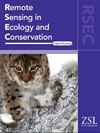Camera traps and deep learning enable efficient large‐scale density estimation of wildlife in temperate forest ecosystems
IF 4.3
2区 环境科学与生态学
Q1 ECOLOGY
引用次数: 0
Abstract
Automated detectors such as camera traps allow the efficient collection of large amounts of data for the monitoring of animal populations, but data processing and classification are a major bottleneck. Deep learning algorithms have gained increasing attention in this context, as they have the potential to dramatically decrease the time and effort required to obtain population density estimates. However, the robustness of such an approach has not yet been evaluated across a wide range of species and study areas. This study evaluated the application of DeepFaune, an open‐source deep learning algorithm for the classification of European animal species and camera trap distance sampling (CTDS) to a year‐round dataset containing 895,019 manually classified photos from 10 protected areas across Germany. For all wild animal species and higher taxonomic groups on which DeepFaune was trained, the algorithm achieved an overall accuracy of 90%. The 95% confidence interval (CI) of the difference between the CTDS estimates based on manual and automated image classification contained zero for all species and seasons with a minimum sample size of 20 independent observations per study area, except for two. Meta‐regression revealed an average difference between the classification methods of −0.005 (95% CI: −0.205–0.196) animals/km相机陷阱和深度学习可以有效地估计温带森林生态系统中野生动物的大规模密度
像相机陷阱这样的自动探测器可以有效地收集大量数据来监测动物种群,但是数据处理和分类是一个主要的瓶颈。在这种情况下,深度学习算法得到了越来越多的关注,因为它们有可能大大减少获得人口密度估计所需的时间和精力。然而,这种方法的稳健性尚未在广泛的物种和研究领域中得到评估。本研究评估了DeepFaune的应用,这是一种开源的深度学习算法,用于欧洲动物物种分类和相机陷阱距离采样(CTDS),该算法包含来自德国10个保护区的895,019张手动分类照片。对于DeepFaune所训练的所有野生动物物种和高级分类群,该算法的总体准确率达到90%。除2个外,在每个研究区最小样本量为20个独立观测点的所有物种和季节中,基于人工和自动图像分类的CTDS估计值差异的95%置信区间(CI)均为零。Meta回归显示,分类方法之间的平均差异为- 0.005 (95% CI: - 0.205-0.196)只/km2。分类成功率与种群密度估计值的散度相关,但假阴性和假阳性检测对不同CTDS参数下种群密度估计值的影响较为复杂。因此,单独的分类性能指标不足以评估深度学习分类器对人口密度估计过程的影响,而应该完全遵循该过程以进行适当的验证。然而,总的来说,我们的研究结果表明,现成的深度学习算法可以用于在很大程度上无监督的工作流程中,从相机陷阱数据中估计种群密度。
本文章由计算机程序翻译,如有差异,请以英文原文为准。
求助全文
约1分钟内获得全文
求助全文
来源期刊

Remote Sensing in Ecology and Conservation
Earth and Planetary Sciences-Computers in Earth Sciences
CiteScore
9.80
自引率
5.50%
发文量
69
审稿时长
18 weeks
期刊介绍:
emote Sensing in Ecology and Conservation provides a forum for rapid, peer-reviewed publication of novel, multidisciplinary research at the interface between remote sensing science and ecology and conservation. The journal prioritizes findings that advance the scientific basis of ecology and conservation, promoting the development of remote-sensing based methods relevant to the management of land use and biological systems at all levels, from populations and species to ecosystems and biomes. The journal defines remote sensing in its broadest sense, including data acquisition by hand-held and fixed ground-based sensors, such as camera traps and acoustic recorders, and sensors on airplanes and satellites. The intended journal’s audience includes ecologists, conservation scientists, policy makers, managers of terrestrial and aquatic systems, remote sensing scientists, and students.
Remote Sensing in Ecology and Conservation is a fully open access journal from Wiley and the Zoological Society of London. Remote sensing has enormous potential as to provide information on the state of, and pressures on, biological diversity and ecosystem services, at multiple spatial and temporal scales. This new publication provides a forum for multidisciplinary research in remote sensing science, ecological research and conservation science.
 求助内容:
求助内容: 应助结果提醒方式:
应助结果提醒方式:


